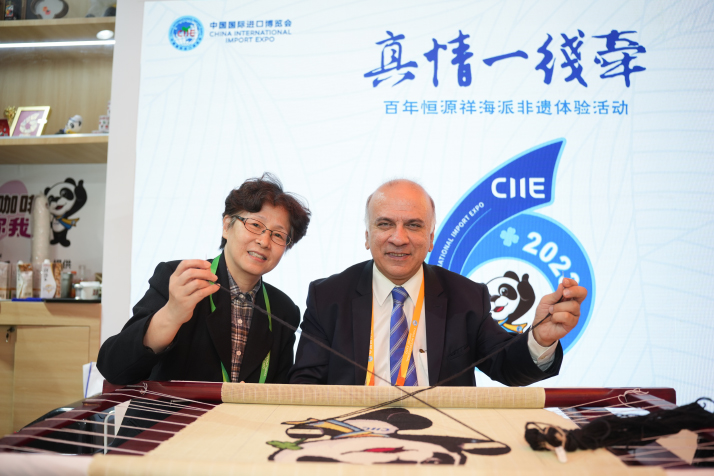| China |
| A common thread | |
|
|
 Marcelo Magnou, Consul General of Uruguay in Shanghai, learns the basic skills of woolen embroidery from Li Qiang at the Sixth China International Import Expo in Shanghai on November 9 (COURTESY PHOTO)
At the Sixth China International Import Expo (CIIE), held in Shanghai on November 5-10, woolen needlepoint tapestry, a national-level intangible cultural heritage, found an international platform. Also known as "woolen embroidery," woolen needlepoint tapestry is a handicraft that uses colored woolen threads to embroider patterns on specially made linen mesh. Li Qiang, an inheritor of the skill, attended the expo on November 9 and displayed the expo's mascot Jinbao created with tapestry and taught basic embroidering skills to visitors. A master of the skill, Li is now the chief craftsperson at the wool embroidery studio of Hengyuanxiang, or HYX Group, a time-honored company founded in 1927 and a leading manufacturer of wool products in China. In the early 1990s, the former president of the group Liu Ruiqi began to gather top craftspeople specializing in woolen embroidery from across China and established studios in the early 2000s to preserve and pass down the unique skills. In contrast to many other forms of intangible cultural heritage in China, Chinese woolen embroidery has been developed based on both Western velvet embroidery and traditional Chinese embroidery techniques. In the decades after Western velvet embroidery was introduced to Shanghai in the early 20th century, local artisans combined it with Shanghai-style patterns, creating a unique new style. The artworks created with the technique are compared to "oriental oil painting," with needles as brushes, threads as paints, and cotton mesh cloth as a canvas. The innovative needlework techniques have allowed for the creation of larger and more diverse works, reproducing both traditional oil paintings and Chinese ink paintings. In 2011, the craft was officially included in the list of national intangible cultural heritage. Li, born in 1957, has been practicing the technique for more than 40 years and excels at embroidering portraits. Many of her works have been collected by museums at home and abroad. Her masterpieces include the reproduction of Michelangelo's The Libyan Sibyl. She used a unique "balanced chiaroscuro technique" to create a sculptural effect, allowing viewers to feel as if they are seeing the original artwork. In her reproduction of Leonardo da Vinci's Lady With an Ermine, she accurately captured the subtle differences in skin tone between characters and recreated the woman's delicate expression. In 2008, she was invited to embroider portraits of eight International Olympic Committee presidents. The final works turned out to be "truly superior to the original manuscript" and are now on display at the Beijing Olympic Exhibition Hall. Li was invited to create the artworks because of HYX Group's long engagement in sport industry. As the official sponsor of the Chinese Olympic Committee, the group has been involved in big events, including the Beijing 2008 Olympic Games and Beijing 2022 Olympic and Paralympic Winter Games. Li Meili, a craftsperson from the wool knitting studio of HYX Group, was responsible for creating award bouquets for the Beijing 2022 Olympic and Paralympic Winter Games. The hand-knitted bouquets consisted of seven different woolen flowers including roses, lilies, osmanthus and green olives. The knitting group, led by Li Meili, made more than 1,200 bouquets. These never-withering bouquets have become a highlight of the event and also reflect the Games' low-carbon concept. Li Meili also brought the bouquets to this year's CIIE. In her eyes, the exquisite craftsmanship, integrating Eastern and Western cultures, is a good carrier for the spirit of the CIIE that bridges East and West. Both Li Qiang and Li Meili are happy to see more organizations and people becoming involved in the protection and promotion of the techniques. In August 2021, an association for woolen needlepoint tapestry was established in Pudong New Area in Shanghai. Many possibilities for the development of the art have been explored, including developing cultural and creative products such as brooches, wallets, cushions, and earrings. Now, Li Qiang is mentor to two young embroiderers at the studio, both graduates from the Shanghai Art & Design Academy. "They need to spend at least three years learning the basic skills," she said. Copyedited by G.P. Wilson Comments to yuanyuan@cicgamericas.com |
|
||||||||||||||||||||||||||||
|
